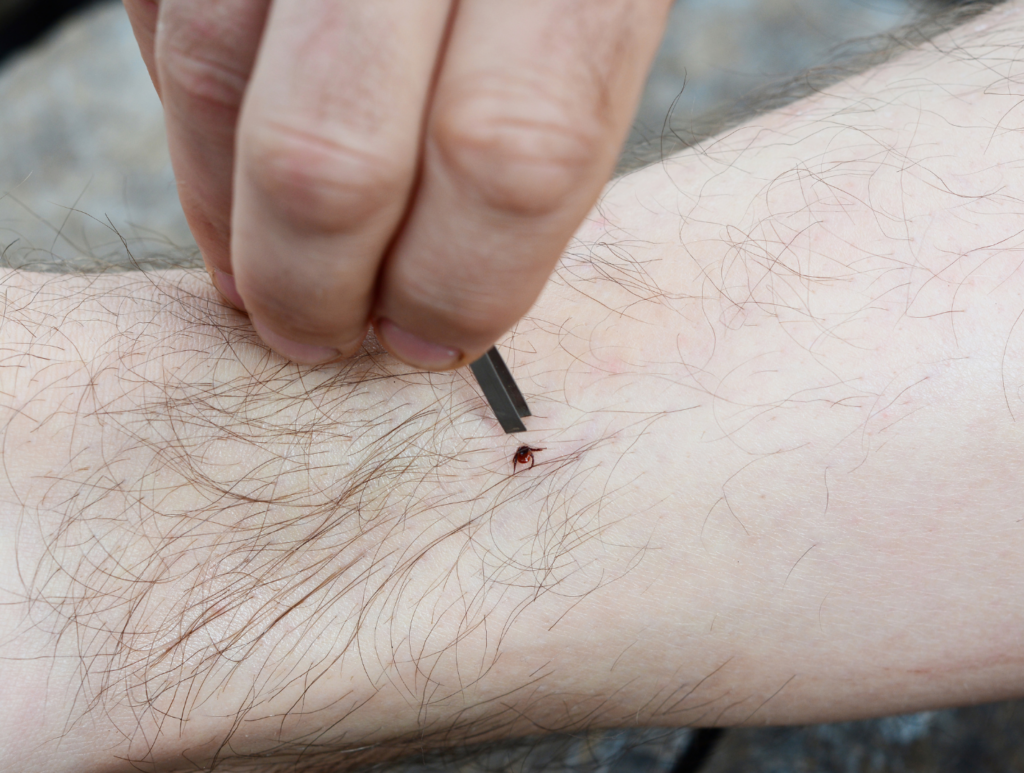Tips for Staying Safe from Ticks
Published on July 31, 2022 by Belle Kuhn

I think we can all agree that ticks are gross, even the thought of them can make you feel icky. But when you or your beloved furry friend are faced with one, it’s good to be prepared and know exactly what to do.
With the higher elevation in Colorado, there are a variety of ticks just waiting to ruin your day. There’s hard ticks, soft ticks and ear ticks. They are literally blood-sucking parasites that can cause not only discomfort and disgust, but disease as well.
Colorado tick fever
This is a viral disease that comes with flu-like symptoms. You may experience headaches, fever, chills, and a feeling of fatigue for a few days followed by recovery and then a second round of symptoms.This is the most common infection caused by the Rocky Mountain wood tick. Symptoms usually develop between three and seven days after the tick bite.
Rocky Mountain spotted fever
This is a rare bacterial disease that can potentially be life-threatening. Early symptoms include headaches and upset stomach, and a rash often develops a few days after fever symptoms. The Rocky Mountain wood tick is the primary vector tick of this disease in Colorado
Tick-borne relapsing fever
Also a bacterial disease with symptoms including high fever, headache, and muscle/joint aches. These last for a few days, then go away for about a week, then return again. The culprit of this one is a soft tick called Ornithodorus hermsi. These bites typically occur in rustic cabins overnight.
Lyme Disease
This is a bacterial infection caused by the bite of the Blacklegged tick. Symptoms include fever, headache, fatigue, and a characteristic skin rash. The tick has to be attached for at least 36 hours for the disease to be transmitted. So if you get it quick, you’re in the clear.
So, let’s try to prevent them in the first place!

Steps you can take to prevent tick bites:
- Avoid their Hang-outs.
- You want to avoid walking through brushy areas and paths through grassy areas and shrublands. Stay in the center of paths and try not to brush up against vegetation where they could be lurking.
- Wear the Right Gear.
- Long-sleeve shirts, pants and high socks will create a barrier and prevent access to your skin. Wear light colored clothing so you can spot them easily.
- Use Tick Repellent.
- DEET is an effective option, but it can be toxic on the skin. Spray on your pants for an extra layer of protection. A healthier option is Skeeter Beater. This spray uses essential oils to ward off ticks and other pesky creatures. It works great, but you may have to reapply hourly.
- Conduct Tick Checks.
- They take a few hours to anchor in to the skin, so check yourself every couple of hours especially if you’re in shorts and a tank top.
Your Furry Friend
How to prevent tick bites for your dog:
- Topical treatments, collars, and shampoos.
- There are many options for each of these on the market and your dog may need to avoid certain ingredients depending on their health history and medications. Talk to your veterinarian or other pet health expert to find one suitable for your dog’s needs.
- Sun and bug blocker overalls.
- Yes, these are overalls for your dog. They may look funny, but they get the job done.
- Regular inspection.
- Check for ticks every couple of hours. Look under the feet and between toes, under the legs, on lips, around eyes and ears and inside the ears, near the anus, and under the tail. If you have a long-haired dog, make sure to check around the neck and collar area.
- Get an Outdoor dog bed.
- Your dog is less likely to get bitten if he/she is on a comfy cushion outside than laying somewhere in the grass or brush. It’s also a good idea to keep your grass as short as possible.

If You Have a Tick
Don’t panic. Everything is going to be ok. The most common tick is relatively easy to remove.
- Grasp the tick with fine tipped tweezers or a special tick remover hook, as close to the skin as possible. If tweezers are not available and you must use your fingers, cover them with tissue or thin plastic to avoid the possible transmission of any disease organisms, such as tularemia, that the tick may harbor.
- Pull the tick slowly and steadily, straight away from the skin. Try not to crush the tick as you remove it.
- After the tick is removed, treat the feeding site with a disinfectant. Wash your hands when done. Never crush a tick with your fingers. Dispose of a live tick by putting it in alcohol, placing it in a sealed bag/container, wrapping it tightly in tape, or flushing it down the toilet.
References:
Colorado State University Extension. (2019, March 20). Colorado Ticks and Tick-Borne Diseases – 5.593. Extension. https://extension.colostate.edu/topic-areas/insects/colorado-ticks-and-tick-borne-diseases-5-593/#:%7E:text=Steps%20to%20Prevent%20Tick%20Bites
Tick prevention for dogs: 6 tips to keep your dog tick free. (2022). My Pet and I. https://uk.mypetandi.com/parasites/ticks/tick-prevention-dogs-6-tips-keep-your-dog-tick-free/






